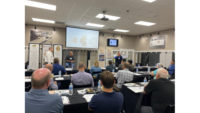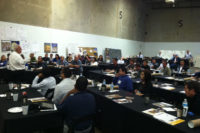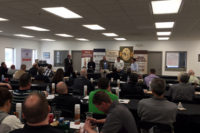Malisani’s presentation went into detail about pricing strategies, marketing techniques and different selling methods as well as how fabricators can better understand and measure their overall business. The presentation concluded with a look at the 2013 MIA Fabricator Benchmarking Report (which was featured in the July issue of Stone World).
After lunch, a tour was given of MSI’s facility. Fabricators had the opportunity to view the company’s extensive selection of stone slabs.
The afternoon concluded with a Fabricator Forum, where topics ranged from ways for fabricators to protect themselves when working with exotic stones, incentive programs for employees, how to retain employees, OSHA inspections, disposing of waste material and what to do with remnants. The panel for the forum included: Joey Ganassa of Washington Marble & Granite Co. in Annapolis, MD, Sam Arcot of Rugo Stone LLC. in Lorton, VA, and Scott Taylor of Charles Luck Stone Center in Richmond, VA.
An early topic discussed during the forum was the importance of having a third party job specifications list that can be used in case of a disagreement about the outcome of a project.
“That’s really where the conflict comes in, when a customer comes back to you and says, ‘This isn’t right,’ and you say, ‘Yes it is, and they say, ‘No it’s not,’” said Malisani. “You have to have something to fall back on, an objective authority, which is what the MIA provides.”
When it came to a discussion about remnants, several audience members spoke about how they handle them. While some fabricators explained that they don’t sell them at all because it is not worth the effort, another said that he charges customers for them. Another participant said that he donates them to local charities.
“We use remnants to get the big kitchen jobs,” said Arcot. “I offer remnants at a cheaper price, and I get them to buy from me because they will see the advantage of getting the big kitchen marbles, and then getting all the remnants.”
One of Ganassa’s issues with remnants is the amount of space that they take up and moving them around. “That’s the problem, you have so many remnants,” he said. “We have a corner of the yard that is just A-frames and A-frames of decent remnants that are good for vanities, but you can’t even get them out to look at. We are doing the same thing and have them for a good price, but then we have to move them six or seven times. It’s a challenge.”
During the forum, the importance of tracking costs also came up. Fabricators agree that taking a close look at how much tooling is being gone through and used during a job should be a part of the price of a job.
“I should be able to get ‘X’ amount of linear feet out of these tools,” said Malisani. “That’s one of the problems with quartz. Because of the way it is constructed, it actually wears the tooling faster than the natural stones, so you have to adjust your price.”
The group also covered the uses and best applications for Dekton by Cosentino. One of the biggest things discussed about it was how to properly fabricate it.
One audience member had done about 20 jobs using the material. He stated the best way to fabricate it is to run it through the machine slower. Once it is installed it is fine, but when it is cut, you have to be careful because of how much tension the pieces have, he explained.
One of the final things the grouped talked about was employee relationships, which also encompassed how to obtain and keep good employees, how to train them, how to keep them happy and how to promote them. Most fabricators found employees through referrals, but a recent trend has been to use social media.
“A well done social media can be a great recruiting tool,” said Malisani. “If your Facebook page makes it look like it’s fun to work there, it helps.”
The Fabricator Forum provided the opportunity for fabricators to talk with each other. At the end of the Stone Summit, participants spent time networking — discussing and solving everyday problems they are encountering with their shops.
The Dulles Stone Summit was one of eight educational seminars Stone World and the MIA are presenting this year. Future events will be held on September 18 in Waite Park, MN, November 6 in Tempe, AZ, and November 13 in Anaheim, CA. For more information regarding these seminars, visit www.stoneindustryeducation.com.







